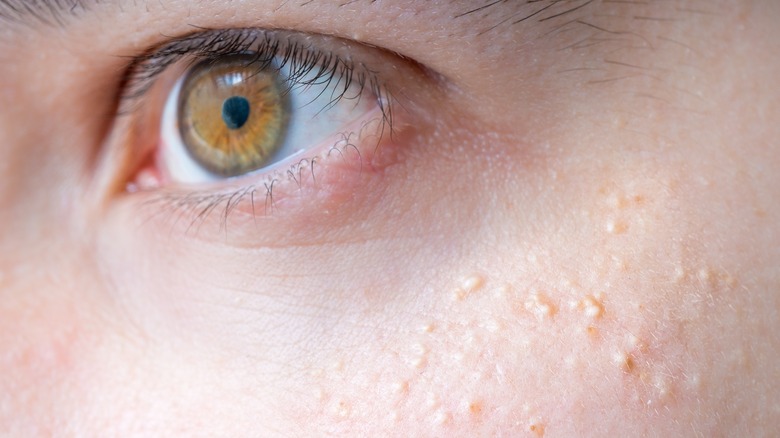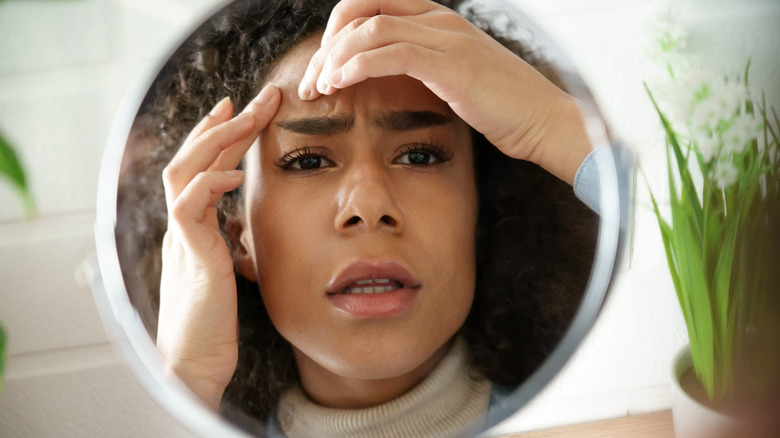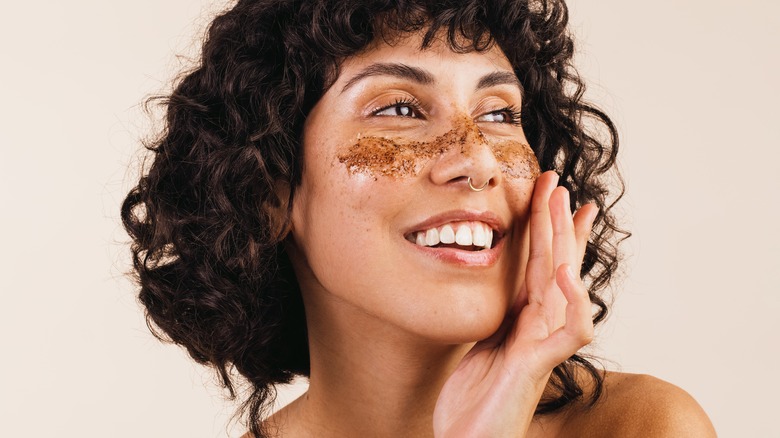Why You Shouldn't Try To Pop Milia
Pimple-popping videos might be satisfying, but scrolling through a YouTube playlist isn't quite the same as earning a doctoral degree in dermatology. When it comes to extracting your own blemishes, it's probably best to leave it to Dr. Sandra Lee (aka Dr. Pimple Popper) and other certified experts. From cystic to mild, acne affects approximately 85% of 12 to 24-year-olds, per Yale Medicine. Though those numbers shrink with age, a quarter of women in their forties still get pimples.
Treatments range from prescription pills to over-the-counter creams depending on severity — really, there's no shortage of skincare products on the market. Though milia — sometimes known as "milk spots" — can resemble raised white heads, they shouldn't be confused for acne. These small, painless cysts form when dead skin cells get trapped just under the skin, not within the pores like standard pimples.
According to Harper's Bazaar, prolonged sun exposure (another reason not to skip the sunscreen) and improperly-absorbed skincare can lead to milia, particularly under the eyes. "Unlike skin on the rest of the face, the eye area does not contain oil glands that can help keep this skin moist and it has limited blood circulation — therefore eye creams need to be very specialized so they can be absorbed properly," explains Dr. John Tsagaris.
Though they're harmless, some choose to treat milia for aesthetic reasons. As is the case with pimples, you should never try to pop these tiny cysts at home. First and foremost, you probably won't be able to.
Popping milia can make them much worse
Whiteheads typically occur when excess sebum (aka our skin's natural oil) clogs pores, but milia build up underneath the skin. Because there's no natural opening like there would be with a pimple or blackhead, you can't pop these tiny cysts without first puncturing the skin. "Squeezing creates trauma and inflammation, and this leads to indents and delayed red marks," warned Darlene O'Gara, National Training Manager at Australian Skin Clinic, in an interview with Body + Soul.
Further, your fingers definitely aren't the best extraction tools, even if they're the most convenient. As facialist Aleksandra Encheva confirmed to Harper's Bazaar, "Squeezing the bump with your bare hands is a big no-no" due to the transfer of bacteria and a high potential for scarring. Encheva cautioned: "You don't want to damage your skin with poor removal techniques." Likewise, specially-designed extraction tools create permanent marks if used improperly.
Though most milia will go away with time, according to Cleveland Clinic, persistent bumps can be quickly cleared with the help of a practiced professional. But be advised that "Milia removal with a skincare professional usually requires an incision, especially when the cysts are deep below the skin's surface," as Encheva noted. Thankfully, it's usually "a quick and painless procedure" conducted "using a comedone extractor, lancing tool, or needle." If you're hoping to treat this condition at home, it's best to rely on topical solutions rather than sharp objects.
Milia can be treated with topical solutions
Milia, especially those bumps under your eyes, can be persistent. Fortunately, because they're often caused by dead skin cells, exfoliants have proven to be an effective treatment method. "A mechanical exfoliant is great to help buff the surface layer once a week, while a chemical exfoliant twice a week will work to break the bonds of dead skin cells that linger on the surface causing congestion and milia," skin specialist Michaella Bolder informed Harper's Bazaar.
Body + Soul points to ingredients like salicylic acid and glycolic acid to treat these unwanted bumps, alongside creams with retinol as a key ingredient. Other healthy practices can help prevent milia patches altogether. Getting into the habit of removing makeup at the end of the day with non-oil-based cleansers — especially around the eyes — can be beneficial. As Byrdie advises, applying retinol-rich eye creams and serums might also do the trick.
These skincare ingredients encourage the production of new, healthy skin cells. "Retinoids can be used and sometimes help to prevent formation," board-certified dermatologist Shari Sperling says, adding, "At home, you can rub a rough washcloth on the skin gently to help loosen it" before massaging in your favorite retinoid. Perhaps most importantly, though, always wear sunscreen.


